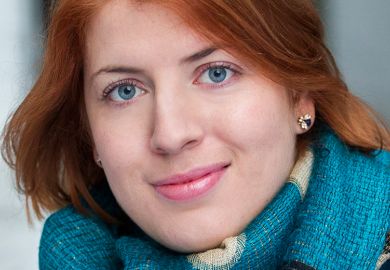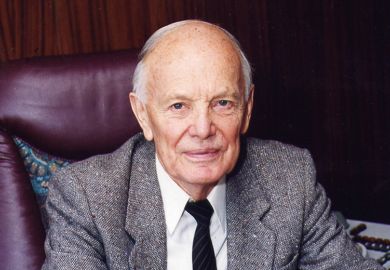Catherine Heymans, professor of astrophysics at the University of Edinburgh, has pioneered techniques for turning data from the cosmos into maps of dark matter. She has written a book, The Dark Universe, and delivered several TED talks, to help explain dark matter and energy to the public. In November she won a €1.5 million (£1.36 million) grant backed by the German government, and in the new year will shift the majority of her research activities to the University of Bonn.
When and where were you born?
I was born in Hertfordshire 40 years ago, in a commuter belt town called Hitchin.
How has this shaped you?
The local state school happened to be an all-girls school for me. Later on, I’ve realised how many of my female academic colleagues also went to a single-sex school. All of the challenges that some girls meet at school when they want to study sciences just weren’t an issue for me at all.
Did you always want to become an astrophysicist?
I’m told that I asked my primary school teacher when I was very little what the most challenging job in the world was, and she said: astrophysics or brain surgery. I just decided I was going to be one of those two.
If you hadn’t become an astrophysicist, what might you have done instead?
I almost didn’t go to university at all: from 15 onwards, I was an apprentice in a woodwind repair shop. But, very sadly, the man training me had a heart attack at a very early age. So it could have been a very different path.
As a physics undergraduate, how did you feel when the theory of dark energy first emerged?
It was 9am, and I was sat in a lecture theatre waiting for our lecturer to turn up – he was late. Eventually he ran into the room and said: “We’re not going to be studying high-energy astrophysics today, because the most amazing paper has just been published – you have to see this stuff.” It was new data that showed that the expansion of the universe was getting faster and faster, which could only be explained by extra, unseen “dark energy” in the universe.
How did this become the focus of your career?
The fate of the universe is very sad, because the universe will just keep expanding and expanding at an ever-increasing rate, until the stars burn out and you can’t see anything. I was determined that this wasn’t going to be right, and did a PhD on this subject to work it all out. Twenty years on, we still don’t know the answer. The “cold death of the universe” theory is very depressing, but there are some lovely gems in there as well. In about 5 billion years, our own Sun will run out of fuel, but what will be left will be a beautiful diamond about the size of the Moon.
Should astrophysicists feel depressed about the fate of the universe?
It’s not very scientific to be emotional about the findings of your research and this leads to an interesting discussion over whether our biases can inadvertently impact our results. When we analyse our data, we now do everything in a blind way, so we can’t be biased.
Do you have any tips for explaining such an intangible subject to the public?
What makes a good science communicator is someone who can come up with good analogies. Even if it’s not a perfect explanation, but something that can link back to everyone’s life, then people can engage with you.
What mistakes do researchers make when they try to explain their work?
Early on in my career, I was told by one of my mentors that I had to include lots of equations in my talks, because otherwise people would think I wasn’t smart. I can remember thinking: but no one can read them in real time. A lot of scientists feel that they have to show off. They want to present themselves as an amazing genius, rather than explaining what they do.
Why are you moving your research from Edinburgh to Bonn?
It’s Brexit. The day after the referendum I started looking for alternative funding, because over my career about 90 per cent of my funding has come from the European Union. The UK government says it will continue to invest in research, but its research is always linked to impact, and the sort of blue-sky research that I do is very hard to link directly to industrial impact. A big component of my work is public outreach where I explain the science that I do, but that tends not to be the impact that the government is looking for: it wants industry, and it wants spin-out companies.
What does your working day look like?
I’m a super-early bird, so I start my day at 5am, and I leave the house long before the kids are even awake, and I’m up at the observatory before the birds are tweeting. I get most of my actual science research, the stuff I really love doing, done before 10am, before anyone else arrives. Then the rest of the day I’m managing my research group. I do my best to leave at 4pm, although that doesn’t always happen.
What do you do for fun?
I would love to say I do things other than my job, but I don’t! I literally skip up the hill to the Royal Observatory every morning: I love my work, I love my family, do both very intensively and that’s all. Somebody once told me you can only do two things well in life, so I don’t try to do anything else.
david.matthews@timeshighereducation.com
Appointments
Joan Gabel has been appointed the University of Minnesota’s first female president. Professor Gabel, who is currently provost at the University of South Carolina, was the sole finalist for the role leading the state university, which has about 50,000 students and an annual budget of $4 billion (£3.2 billion). She will succeed Eric Kaler, who has led the institution since 2011. David McMillan, chair of Minnesota’s board of regents, said Professor Gabel “stood out from a highly competitive pool of candidates”. “Her qualifications, combined with her warmth, energy and her genuine engagement with students, faculty, staff and others are proof that she will make an outstanding president,” he said.
Graham Upton is the new interim vice-chancellor of Bangor University. Professor Upton, who led Oxford Brookes University from 1997 to 2007, has been interim vice-chancellor at Birmingham City University, the University of Cumbria and Wrexham Glyndwr University. He took up his post on 1 January, replacing John Hughes, who was due to retire at the end of the academic year but instead left at the end of December. Marian Wyn Jones, Bangor’s chair of council, said that “given the number of challenges currently facing the university…we concluded that it would be in the university’s best interests for those issues to be dealt with by a team which will be able to see through the changes, not only during the forthcoming months, but crucially also into the next academic year”.
Craig Callum is to be the next director of the National Transport Design Centre at Coventry University. He will join the centre, which opened in 2017 and is part of the university’s Institute for Future Transport and Cities, after a stint as a design manager at Lego.
Catherine Marks is Bond University’s new vice-president (engagement). She joins the Queensland institution from Swansea University, where she was director of global advancement.
Register to continue
Why register?
- Registration is free and only takes a moment
- Once registered, you can read 3 articles a month
- Sign up for our newsletter
Subscribe
Or subscribe for unlimited access to:
- Unlimited access to news, views, insights & reviews
- Digital editions
- Digital access to THE’s university and college rankings analysis
Already registered or a current subscriber?




